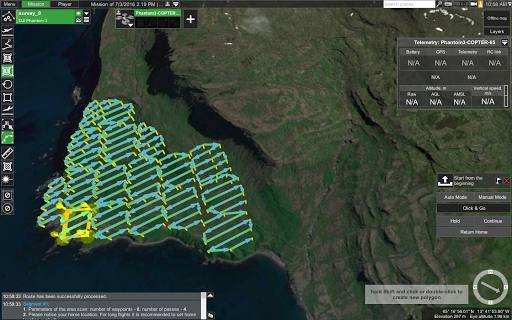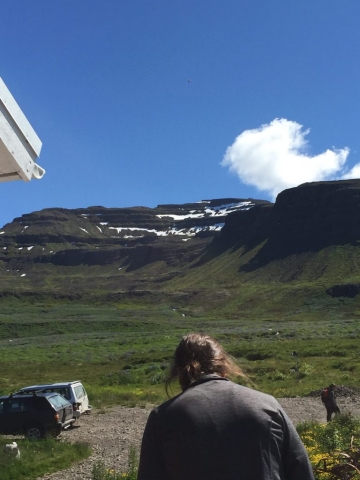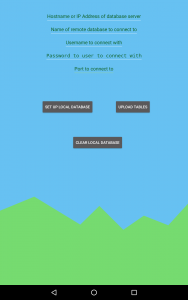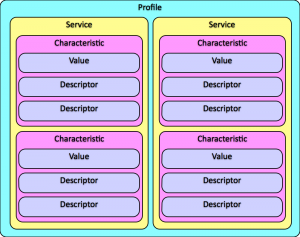Today was another sunny, beautiful day at Skalanes. We woke up to the sun shining down and just a couple of clouds in the sky. We started the day with breakfast outside on the patio and then we all got to work.
There was a lot that was being worked on today. Erin and Nic were working on flying the drone. Erin was controlling the drone outside while Nic was in the door working on the computer. A Nexus running the Dji application is placed in the drone controller for flying, but the Nexus also needs to be connected to WiFi to communicate with the ground station program on Nic’s computer. Once they stepped outside of the room, the Nexus was losing WiFi access. We found really long micro USB cable so the Nexus could stay inside while the controller was outside with Erin flying blind. The ground station program on Nic’s computer allows the drone to go on autopilot. They were eventually able to get it to go on autopilot for a few minutes which was pretty cool. It was a little freaky yesterday when we told the drone to come home (where it took off from), then Nic decided to land it somewhere else so he tried to take control but the drone wouldn’t release control of itself. Nic was able to make a complete flight plan on the ground station software for the archaeological sites. I’ve posted a couple of pictures of Erin flying the drone and the final flight plan below.
Tara did a lot of work on the soil samples. Instead of putting them in the oven, she took advantage of all the sunshine and had them dry in the sun for the past two days. They need to be dry in order to work with the Nano IR for spectroscopy. Tara sifted soil samples to remove the big rocks and then crushed what was left to make the samples more sandy. The standards that Tara made back in Richmond for the soil samples here were made with sandy soil, which is what much of Iceland is. The 20 samples from the glacier were much harder than the tephra layers from the riverbed. The tephra layers were basically mud that dried so they didn’t need to be sifted, just crushed to make sure they had the consistency of sand. This was all done outside on the deck and it was sunny enough that she got sunburnt! Something to think about next time is bringing a mortar and pestle to crush the soil. She was using some kind of fishing hard plastic thing to crush, which worked out surprisingly well. There were a couple of samples that were too rocky so she took some from the soil bag and let it dry in the sun that day too. Good thing we took more soil than we needed!
I did some work on Field Day and the Ambiance platforms sketches. We noticed that the altitude on from the sensors on the Ambiance platform was a little off — when we were upstairs in our ‘office’ it was telling us we were -40 below sea level. Charlie made a calibration code for the devices where it takes a known altitude that the user provides through Field Day and makes a correction value that is applied to the altitude taken from the sensors. So if we go down to the sea and give a calibration value of 0 since we’re at sea level, and the sensor is giving us -4, the correction value will be +4. The sensor isn’t really stable enough to give us exactly zero for a reading, but it’s pretty close.
I also did some work on the BLE reliability with Field Day. I left the platform running with Field Day plugged into my computer so I could look at the logs when it eventually stopped. I realized that after a little while the messages to Field Day would eventually get jumbled which caused Field Day to be confused. Field Day was sending messages too often, so it hadn’t finished processing the response before the next response came. This was done using a Handler and Runnable. I changed Field Day to only send another request to the bluetooth device once the response from the previous request had been processed. This has helped a lot. Before Field Day was only getting a hour or so of good reading from the device, but I left it running last night and it went from about 7:30 at night until 2 in the morning. I was really happy with that result. I learned that native Android has known issues with Bluetooth Low Energy and different Bluetooth chips has different issues as well. One thing that stuck out when I was reading was the unreliability with sending and receiving longer messages. The Ambiance sketches send long messages because there are so many sensors on the platform.
Deeksha worked on the visualization and produced some CSV’s from our trip on Heimaey and the glacier for Erin to put into GIS which was pretty cool. Charlie worked on added the BME280 chip to Dart, one of our ambiance platforms and rewiring Grace to work with the ambiance sketch pin settings. Gail worked on thinking about this trip in terms of wilderness and outdoor education program. She’s been thinking about sample day plans, how long we would need to stay at places, what kinds of topics would be interesting where, and what they would need to bring or have available. Needless to say, it was quite a long and successful day at Skalanes.
We finished the day with a bonfire at the beach. Our group, Oli, Rannveig and the Glasgow group that’s also staying at Skalanes were there enjoying the sunshine and hard work of the day. Erin and Charlie jumped all the way the water which was ice cold! Gail, Tara and I just stuck our toes in which was enough since the water so cold it hurt!









